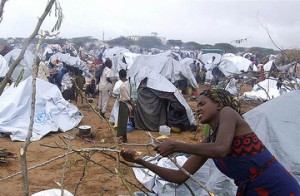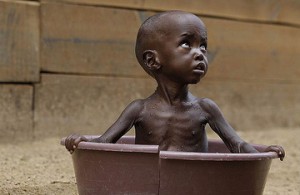News Update:
Tuesday, August 2, 2011
“In Ethiopia’s rain-starved eastern badlands, livestock is the sole asset for most. Swaddled in robes, pastoralist families traverse huge tracts searching for water and pasture for their herds, uprooting camps as they go. When seasonal rains fail, life becomes a battle for survival,” reports csmonitor.com.
“As aid agencies scramble to feed some 11.5 million people suffering from what is being called the Horn of Africa’s worst drought in 60 years, Ethiopia’s government is enacting a resettlement program that it hopes will be a longlasting solution to a longstanding burden.”
Read More.
—
Related:
World Bank Drought Plan Focuses on Ethiopia, Kenya (VOA)
By Gabe Joselow | Nairobi
July 29, 2011
The World Bank Friday unveiled new details of its plan to help victims of drought in the Horn of Africa. The bulk of the effort focuses on Ethiopia and Kenya, not Somalia.
The bank’s Country Director for East Africa Johannes Zutt says over $600 million is being made available to those affected by the drought in Somalia, Ethiopia and Kenya.
But only $9 million is going directly toward disaster relief in Somalia, the worst hit country in East Africa.
Zutt says the problem is access.
Watch New Video: Horn of Africa Famine Puts 11 Million People at Risk of Hunger (PBS News)
—
Related:
World Reacts to Avert Famine in East Africa
Tadias Magazine
News Update
Thursday, July 28, 2011
New York (Tadias) – The UN’s World Food Program has started airlifting supplies of emergency food into the Somali capital Mogadishu, as relief and fundraising efforts continued for millions of people affected by the looming hunger crisis in drought-hit areas of East Africa.
At an emergency meeting held at the Food and Agriculture Organization headquarters in Rome recently, WFP Executive Director Josette Sheeran warned the international community the problem could become a wider catastrophe unless immediate action is taken. “The drought has swept the Horn of Africa where more than 11 million people are in need of food assistance,” she said. “We are particularly worried about Somalia right now and it is vital that we reach those at the epicentre of the famine with food assistance.”
The United Nations says the developing crisis is the largest famine in 60 years. Nearly 12 million people are thought to be at risk of food insecurity in Somalia, Ethiopia, Kenya, Eritrea and Djibouti. Ethiopians constitute 4.56 million of the current total food insecure populations in the region. According to UNICEF, 2.23 million children in Somalia, Ethiopia, and Kenya are estimated to be acutely malnourished. And nearly 720,000 children are at risk of death without urgent assistance.
“The area straddling Somalia, Ethiopia and northern Kenya, has been dubbed the “triangle of death” as the worst drought in more than fifty years grips the area,” writes Stewart M. Patrick, a senior fellow at the Council on Foreign Relations and Director of the Program on International Institutions and Global Governance. “An estimated thirty percent of children are malnourished, many arriving in refugee camps so “emaciated and with skin lesions so deep that you could see their bones showing in their skulls and arms.” According to testimony by State Department official Reuben Brigety, acute malnutrition has reached 50% and 40%, respectively, in Ethiopia and Kenya—far above the 15% threshold for an international humanitarian emergency.”
Per AFP: “Officials said the UN had received about $US1 billion ($A924.56 million) since first launching an appeal for the region in November 2010 but needs a billion more by the end of the year to cope with the emergency. The World Bank on Monday pledged more than $500 million, with the bulk of the money set to go towards long-term projects to aid livestock farmers while $12 million would be for immediate assistance to those worst hit by the crisis. However charities have slammed low aid pledges and say not enough is being done.”
Read more.
—
Cover image: A woman from southern Somalia struggles to build a makeshift shelter from tree branches at a new camp in Mogadishu, Somalia, on July 13. (Mohamed Sheikh Nor / AP)
Related:
Historic Famine in East Africa Conjures Depressing Sense of Deja Vu
Tadias Magazine
Editorial
Updated, July 27, 2011
New York (Tadias) – A humanitarian crisis of historic proportions is unfolding in drought-hit areas of East Africa, including Somalia, Ethiopia, Djibouti and Kenya. The United Nations says the pending disaster is the largest famine in 60 years.
The UN warns relief is needed urgently and should not be ignored or the world will once again be witnessing the repeat of history, this time on a much larger scale. Unless quickly prevented, nearly 12 million people are thought to be at risk of food insecurity in the Horn of Africa this year. That’s an alarmingly large number of people affected in contrast to the widely publicized 1984 famine that killed approximately one million people. Ethiopians constitute 4.56 million of the current total food insecure populations in the region.
Sadly, the familiar images of hungry children with skinny, malnourished bodies on television screens and front-pages of newspapers around the world, conjures depressing sense of déjà vu for the international community. According to UNICEF, in total 2.23 million children in Ethiopia, Kenya and Somalia are estimated to be acutely malnourished. And nearly 720,000 children are at risk of death without immediate assistance.
Dr. Reuben Brigety, Deputy Assistant Secretary of State for Population, Refugees and Migration, said in a testimony before the House Subcommittee on Africa earlier this month that “in Ethiopia, global acute malnutrition rates close to 50% have been reported among newly arriving refugee children.” Dr. Brigety added: “This situation is substantially worse than when I last visited the Dolo Odo refugee camps in Ethiopia in February of this year. Newly arriving children are now dying in the refugee camp at the rate of two to three per day.”
The United Nations Food and Agricultural Organization held an emergency meeting in Rome on Monday to discuss campaign strategy to moblize and deliver aid to the region. The meeting was attended by representatives from the G20 countries, ministers and senior officials from UN’s 191 member nations, other U.N. bodies, NGOs and regional development banks.
The UN has officially declared famine in parts of Somalia and it has designated large areas in Ethiopia, Djibouti and Kenya as a crisis or an emergency zone.
Watch: UN Declares Famine in Somalia, Channel 4 News
“This summer has been an unspeakable nightmare for millions of children in the Horn of Africa,” said President and CEO of the U.S. Fund for UNICEF Caryl Stern. “We cannot control the weather patterns that have led to drought and famine, but we can do something about helping those who suffer from it. The sooner we act, the more children’s lives can be saved. As little as $10 can feed a child for 10 days.”
UNICEF estimates it will need $100 million over the next six months for a massive scale up of operations to reach children in the drought affected areas with emergency and preventative assistance.
“UNICEF is using every means possible to reach every child. There simply can be no compromise on the objective to keep children and their families alive,” said Elhadj As Sy, Regional Director for UNICEF Eastern and Southern Africa. “We appreciate the generosity of the international community and those contributions are already making a difference. We urgently need more funds to meet the enormous need.”
————-
For more information or to make a tax-deductible contribution to relief efforts in the Horn of Africa, please contact the U.S. Fund for UNICEF: Website: www.unicefusa.org/donate/horn. Or call toll free: 1-800-4UNICEF (1-800-486-4233). Text: Text “FOOD” to UNICEF (864233) to donate $10. Mail: 125 Maiden Lane, New York, NY 10038.
Cover photo: Aden Salaad, 2, looks up at his mother as she bathes him in a tub at a Doctors Without Borders hospital, where Aden is receiving treatment for malnutrition, in Dagahaley Camp, outside Dadaab, Kenya, on Monday, July 11. (Rebecca Blackwell / AP)
Video: East Africa Food Crisis – Somalia Faces Famine as al-Qaida Threat Halts International Aid

